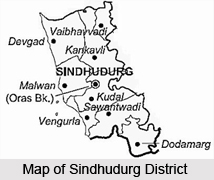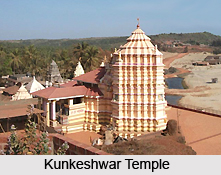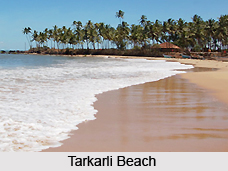 Sindhudurg district covers an area of 5,207 sq. kms in the state of Maharashtra. The modern township of Sindhudurgnagari is the headquarters of Sindhudurg district. The district is surrounded by the Arabian Sea on the east, the Belgaum District (Karnataka) and Goa on the south and the Ratnagiri district on the North. Sindhudurg being a coastal district, the climate is generally moist and humid and the temperature variations during the day and throughout the seasons are not large. Sindhudurg is accessible by road on the NH-17 which passes through the major towns of Kankavli, Kudal and Sawantwadi or by the picturesque journey on the Konkan Railway which stops at Kankavli, Sindhudurg, Kudal and Sawantwad. The nearest airports are at Ratnagiri, Belgaum (Karnataka) and Dabolim (Goa). Apart from its scenic natural beauty, the district is famous for tropical fruits like the world famous Alphonso mangoes, cashews, Jamuns etc.
Sindhudurg district covers an area of 5,207 sq. kms in the state of Maharashtra. The modern township of Sindhudurgnagari is the headquarters of Sindhudurg district. The district is surrounded by the Arabian Sea on the east, the Belgaum District (Karnataka) and Goa on the south and the Ratnagiri district on the North. Sindhudurg being a coastal district, the climate is generally moist and humid and the temperature variations during the day and throughout the seasons are not large. Sindhudurg is accessible by road on the NH-17 which passes through the major towns of Kankavli, Kudal and Sawantwadi or by the picturesque journey on the Konkan Railway which stops at Kankavli, Sindhudurg, Kudal and Sawantwad. The nearest airports are at Ratnagiri, Belgaum (Karnataka) and Dabolim (Goa). Apart from its scenic natural beauty, the district is famous for tropical fruits like the world famous Alphonso mangoes, cashews, Jamuns etc.
Location of Sindhudurg District
Sindhudurg district is situated between the north latitudes of 15.37 and 16.40, and the east longitudes of 73.19 and 74.18. It is bounded by the Arabian Sea on the West and Sahyadri hill ranges to the East with a total area of 5,207 sq.km. Sindhudurg lies in the Kokan area of Maharastra along the western coast of India. National Highway 17 passes through this area. With 7 railway stations, a 103 Km stretch of Konkan Railway line passes through this district. It has good road and rail links with Goa and Mumbai.
 History of Singhudurg district
History of Singhudurg district
History of Sindhudurg district is one with that of the Konkan region of which it is a part. The history of Konkan district goes back a very long way. It is said that the Pandavas of Mahabharat had settled here when they were on their exile. Following its mythological past, the district of Sindhudurg, as also the whole of the Konkan region, has been under the rule of a number of different dynasties. These include the Mauryas, Nala, Silaharas etc. The whole of the western coastal region came under the influence of the Portuguese in the 16th century. With the rise of Chatrapati Shivaji, the district fell into the hands of the Marathas. They held sway over the region till it was annexed to the British in 1817. Sindhudurg district was earlier a part of the Ratnagiri district. For administrative convenience and industrial and agricultural development Ratnagiri district was divided into Ratnagiri and Sindhudurg with effect from 1st May, 1981. Sindhudurg district now comprises of eight tahsils of Sawantwadi, Kudal, Vengurla, Malvan, Devgad, Kankavli, Vaibhavwadi and Dodamarg.
Geography of Sindhudurg District
The climate in the district of Sindhudurg is quite humid and moist. The minimum temperature in the district touches 16.3 degree Celsius whereas the maximum temperature hovers at around 33.8 degree Celsius. Sindhudurg witnesses rain for the full four months of June, July, August and September. The average rainfall is very high but almost all the rainwater causes surface run off, due to undulating topography and lack of any water impounding major and medium structures. The average rainfall in the district is 3287 mms. The important rivers flowing through the district are the Terekhol River, the Gad River, the Devgad River, the Karli River and the Vaghotan River.
 Tourism in Sindhudurg District
Tourism in Sindhudurg District
The district of Sindhudurg has a number of beautiful and enchanting places of tourism to offer the tourists. It is well known for the many places of natural beauty located here, which include waterfalls, lakes, hills and the beautiful backwaters. The district is most famous for the many pristine beaches located here such as the Tarkarli beach and the Valagar beach. There are also many monuments of antiquity situated here, which are very popular among tourists in the district. These include the various forts located here, most of which have been built by Shivaji. The most famous fort in the district is the fort of Sindhudurg, based on which the district has acquired its name. There are many other forts here such as the Vijaydurg, Bharatgad, Bhagwatgad, Sarjekot etc. Among the places of pilgrimage tourism are temples like the Kunkeshwar Temple, Rameshwar Temple, Redi Ganapati etc.






